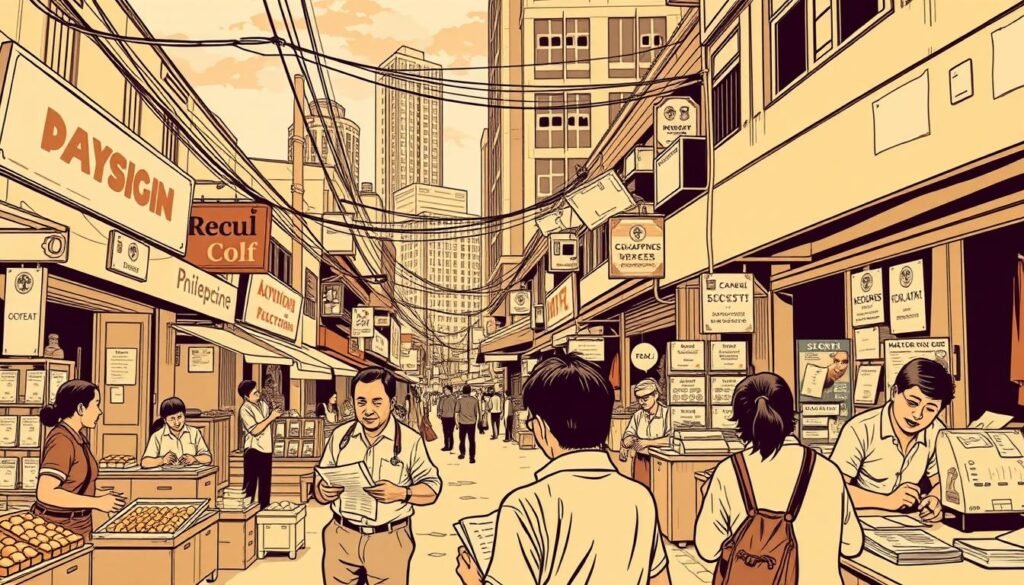The relationship between the United States and the Philippines has long been shaped by economic policies that influence growth and development. These guidelines have played a crucial role in shaping the regulatory and organizational frameworks of the Philippines, impacting both governance and business sectors.
Historically, the U.S. has introduced reforms that have transformed the economic landscape of the Philippines. From trade agreements to investment programs, these policies have created processes that foster collaboration and innovation. This partnership has helped the Philippines adapt to global economic challenges while strengthening its local industries.
Understanding the difference between policies and laws is essential. While laws enforce rules, policies provide a blueprint for decision-making and strategic planning. This distinction highlights how American economic strategies have become a critical tool for transformation in the Philippines.
Key Takeaways
- American economic policies significantly influence the Philippines’ regulatory frameworks.
- Historical ties between the U.S. and the Philippines shape economic collaboration.
- Policies act as blueprints for decision-making and strategic planning.
- Trade agreements and investment programs drive economic growth.
- Understanding the difference between policies and laws is crucial for economic development.
Introduction: American Economic Influence on the Philippines
The economic ties between the United States and the Philippines have evolved significantly over the decades. From trade agreements to investment programs, the U.S. has established a robust framework that continues to shape the Philippines’ economic landscape. This partnership has not only driven growth but also set a standard for collaboration in the region.

Overview of U.S. Economic Ties
Historically, the U.S. has introduced economic systems that have transformed the Philippines. For example, the Payne-Aldrich Tariff Act of 1909 allowed free entry of Philippine products into the U.S. market. This move strengthened trade relations and boosted local industries.
Another key example is the Enhanced Defense Cooperation Agreement (EDCA), which allocated $109 million for military facility improvements. Such initiatives highlight the U.S. commitment to fostering economic and security ties with the Philippines.
How-To Guide: Setting the Stage for Change
Adapting to economic shifts requires a clear framework. Organizations in the Philippines can follow these steps to ensure resilience:
- Assess current economic conditions and identify areas for improvement.
- Align internal processes with global standards to enhance competitiveness.
- Leverage data-driven strategies to make informed decisions.
By following this way, businesses can navigate challenges and capitalize on opportunities effectively.
| Initiative | Impact |
|---|---|
| Payne-Aldrich Tariff Act | Boosted trade relations |
| Enhanced Defense Cooperation Agreement | Strengthened security and economic ties |
| USAID Investments | Improved disaster resilience and market-driven growth |
Understanding these systems and their impact is crucial for organizations aiming to thrive in a dynamic economic environment. By adopting a proactive way of thinking, businesses can set the stage for long-term success.
Historical Background of U.S. Economic Reforms
The economic reforms introduced by the United States have played a pivotal role in shaping the Philippines’ development trajectory. These reforms have provided a framework for growth, influencing industries and public administration. Over the decades, key milestones have defined the relationship between the two nations, creating lasting benefits for the Philippines.

Key Milestones Shaping the Relationship
One of the earliest reforms was the Payne-Aldrich Tariff Act of 1909. This act allowed Philippine products to enter the U.S. market duty-free, boosting trade and local industries. It set a guideline for future economic collaborations.
Another significant milestone was the establishment of USAID programs in the 1960s. These programs focused on disaster resilience and market-driven growth, providing essential services to communities. They also helped modernize the Philippines’ industry sectors.
The Enhanced Defense Cooperation Agreement (EDCA) in 2014 further strengthened ties. It allocated $109 million for military facility improvements, enhancing both security and economic cooperation. This agreement highlighted the U.S. commitment to the Philippines’ development.
| Milestone | Impact |
|---|---|
| Payne-Aldrich Tariff Act | Boosted trade and local industries |
| USAID Programs | Improved disaster resilience and market growth |
| Enhanced Defense Cooperation Agreement | Strengthened security and economic ties |
These milestones demonstrate how U.S. reforms have provided valuable information and resources. They have shaped the Philippines’ economic landscape, fostering growth and innovation. By following these guidelines, the Philippines has been able to adapt to global challenges effectively.
Understanding the evolution of these reforms is crucial. They have not only influenced industries but also set standards for public administration. This historical background highlights the enduring benefits of U.S.-Philippines economic collaboration.
Understanding Policies in the Economic Framework
Economic frameworks rely heavily on well-defined strategies to guide operations and decision-making. These strategies act as blueprints for addressing challenges and ensuring efficiency in both corporate and governmental settings. They provide a structured approach to solving problems and fostering growth.

Definition and Role of Strategies
Strategies within economic management are designed to streamline operations and ensure efficiency. They are distinct from laws, which enforce rules, and rules, which dictate specific actions. Instead, strategies offer a flexible framework for making informed decisions.
For example, in the Philippines, the Policy Framework for Investment (PFI) has been instrumental in shaping economic growth. It provides guidelines for attracting investments and improving market-driven growth. This framework highlights the importance of strategic planning in addressing economic problems.
Guiding Decision-Making Through Strategies
Strategies play a crucial role in guiding decision-making at all levels. They help organizations identify areas for improvement and align their processes with global standards. This ensures competitiveness and resilience in a dynamic economic environment.
One key challenge is operationalizing these strategies effectively. Organizations must adapt to changing conditions and leverage data-driven approaches. For instance, the legacy of William Cameron Forbes in the Philippines demonstrates how strategic planning can drive long-term success.
| Strategy | Impact |
|---|---|
| Policy Framework for Investment | Attracts investments and improves market growth |
| Data-Driven Decision-Making | Enhances competitiveness and resilience |
| Adaptive Operational Strategies | Addresses economic problems effectively |
By understanding and implementing these strategies, organizations can navigate economic challenges and achieve sustainable growth. They work to streamline operations and ensure efficiency, ultimately driving progress in the Philippines.
Exploring Policy Processes and Decision-Making
The process of creating and implementing effective strategies involves multiple stages, each critical to achieving desired outcomes. From initial agenda-setting to final evaluation, these steps ensure that actions are aligned with organizational goals and address key issues effectively.

Stages of Policy Formulation
Policy formulation begins with identifying and prioritizing issues. This stage involves research and analysis to understand the problem and its impact. Stakeholder engagement is crucial here, as it ensures that diverse perspectives are considered.
Next, policymakers develop potential solutions. These solutions are shaped through negotiation and collaboration, ensuring they are practical and aligned with organizational rules. For example, the Policy Framework for Investment in the Philippines was designed to attract foreign investments while addressing local economic challenges.
Implementation and Evaluation in Practice
Once a strategy is formulated, the focus shifts to implementation. This stage requires coordination among various stakeholders to allocate resources effectively. Clear communication and leadership are essential to ensure that actions are executed as planned.
Evaluation is the final step, where outcomes are measured against desired goals. This process helps identify what worked and what didn’t, providing valuable insights for future practice. For instance, the Enhanced Defense Cooperation Agreement (EDCA) was reviewed to assess its impact on both security and economic cooperation.
Effective strategies not only address immediate issues but also set the foundation for long-term success. By following these stages, organizations can ensure that their actions are impactful and aligned with their overall objectives.
Navigating Policy Changes: A How-To Guide for Organizations in the Philippines
Organizations in the Philippines must navigate economic shifts with agility to stay competitive. Adapting to new guidelines requires a structured approach, focusing on management and operational efficiency. By embracing change, businesses can turn challenges into opportunities for growth.

Strategies for Adapting to Economic Shifts
Economic shifts often demand quick adjustments. Here are practical strategies to help organizations thrive:
- Assess the Impact: Evaluate how new guidelines affect your operations at every level.
- Engage Stakeholders: Collaborate with teams to ensure alignment and buy-in for new processes.
- Leverage Data: Use analytics to make informed decisions and identify areas for improvement.
Effective management plays a crucial role in implementing these strategies. Leaders must communicate clearly and provide the necessary resources to support their teams.
Steps to Update Corporate Processes
Updating corporate processes is essential for aligning with new economic guidelines. Follow these steps to ensure a smooth transition:
- Document Procedures: Clearly outline updated processes to avoid confusion.
- Train Employees: Provide training to ensure everyone understands the new policy process.
- Monitor Progress: Regularly review outcomes and make adjustments as needed.
By refining the policy process, organizations can streamline decision-making and enhance resilience. This approach ensures that businesses remain adaptable in a dynamic economic environment.
Navigating change requires a proactive mindset and a commitment to continuous improvement. With the right strategies and management, organizations in the Philippines can achieve long-term success.
Regulatory Impacts on Trade and Investment
Trade and investment between the U.S. and the Philippines are deeply influenced by regulatory frameworks. These frameworks shape how businesses operate, impacting everything from import-export processes to resource allocation. Understanding these regulations is crucial for navigating the complexities of global trade.

Policies Affecting Import-Export Operations
Regulatory shifts often create challenges for import-export operations. For instance, outdated rules can restrict trade, while new guidelines may require businesses to adapt quickly. A proactive approach is essential to address these situations effectively.
One example is the reduction of regulations in South Korea, which led to a 50% decrease in trade barriers. This approach highlights how streamlined regulations can optimize resources and improve competitiveness. Similarly, the Philippines can benefit from adopting such strategies to enhance its trade operations.
Strategies for Adapting to Regulatory Shifts
Businesses must develop strategies to adapt to regulatory changes. Here are some key steps:
- Assess the Impact: Evaluate how new regulations affect operations at every level.
- Engage Stakeholders: Collaborate with teams to ensure alignment and buy-in for new processes.
- Leverage Data: Use analytics to make informed decisions and identify areas for improvement.
By following these steps, businesses can turn regulatory challenges into opportunities for growth. For example, the U.S. agricultural trade programs demonstrate how targeted strategies can expand markets and optimize resources.
Optimizing Resources in Trade Operations
Effective trade policies can lead to significant resource optimization. For instance, the Good Regulatory Practices (GRP) framework emphasizes the importance of aligning regulations with trade goals. This approach ensures that businesses can operate efficiently while complying with international standards.
In the Philippines, adopting similar frameworks can help streamline trade processes and address challenges effectively. By focusing on resource optimization, businesses can achieve long-term success in a dynamic economic environment.
Leveraging Data for Evidence-Based Policy Making
Data-driven decision-making has become a cornerstone of effective economic strategies in the Philippines. By combining quantitative and qualitative analysis, policymakers can craft solutions that address specific goals and challenges. This approach ensures that decisions are grounded in accurate information, leading to more impactful outcomes.

Using Quantitative and Qualitative Analysis
Quantitative analysis involves the use of numerical data to identify trends and patterns. For example, unemployment rates and trade statistics provide valuable insights into economic conditions. Qualitative analysis, on the other hand, focuses on understanding the context behind the numbers. This dual approach helps policymakers develop comprehensive solutions.
One effective method is the integration of advanced analytical tools. These tools enable the processing of large datasets, revealing insights that might otherwise go unnoticed. For instance, predictive analytics can forecast economic trends, helping policymakers set realistic goals.
The Role of Information in Shaping Economic Policy
Accurate information is critical for shaping economic policy. It ensures that strategies are aligned with current conditions and future needs. Clear terms and definitions are essential for effective communication among stakeholders.
For example, the evidence-based policy-making approach emphasizes the use of reliable data to inform decisions. This method has been instrumental in addressing issues like youth unemployment and skill mismatches in the Philippines.
- Data-driven analysis is essential for developing evidence-based policies.
- Quantitative and qualitative methods provide a comprehensive view of economic challenges.
- Accurate information ensures that policies are aligned with specific goals.
- Advanced tools like predictive analytics enhance decision-making capabilities.
By leveraging data, policymakers can create solutions that are both effective and adaptable. This approach not only addresses immediate challenges but also sets the foundation for long-term economic growth.
Addressing Challenges and Unintended Outcomes
Implementing economic strategies often brings unexpected challenges that require careful navigation. These challenges can stem from misaligned goals, inadequate planning, or unforeseen consequences. Addressing them effectively ensures that strategies achieve their intended impact.

Common Pitfalls in Policy Implementation
One major pitfall is the lack of alignment between a strategy’s goals and the practical needs of the group it aims to serve. For example, the Dodd-Frank Act on conflict minerals led to unintended disruptions in supply chains. This highlights the importance of thorough research and stakeholder engagement.
Another challenge is the complexity of regulatory environments. In the Philippines, rural-urban migration has created new economic pressures that existing strategies struggle to address. This underscores the need for adaptive planning and continuous evaluation.
Unforeseen Outcomes and Their Impact
Unintended outcomes often arise when strategies fail to account for local contexts. For instance, the unintended consequences of public health policies can include reduced access to essential services. These outcomes highlight the importance of context-specific planning.
Individual decisions within an administration can also have broader impacts. For example, a person’s choice to prioritize short-term gains over long-term sustainability can undermine the success of a strategy. This emphasizes the need for clear guidelines and accountability.
Collaboration for Policy Success
Effective collaboration within groups is essential for overcoming challenges. By fostering open communication and shared goals, stakeholders can work together to address issues as they arise. This approach ensures that strategies remain adaptable and responsive.
For example, the Pantawid Pamilyang Pilipino Program (4Ps) in the Philippines demonstrates how collaboration can lead to positive outcomes. By involving local communities in the planning process, the program has successfully improved education and health services.
Recommendations for Future Planning
- Engage Stakeholders Early: Involve all relevant groups in the planning process to ensure alignment with practical needs.
- Conduct Thorough Research: Use data-driven analysis to anticipate potential challenges and unintended outcomes.
- Adapt to Local Contexts: Tailor strategies to address the unique needs of each community or administration.
- Monitor and Evaluate: Continuously assess the impact of strategies and make adjustments as needed.
By addressing these challenges proactively, organizations and administrations can ensure that their strategies achieve their intended goals. This approach not only mitigates risks but also fosters long-term success in a dynamic economic environment.
Case Studies: Impact on Philippine Businesses and Governance
The impact of American economic strategies on Philippine businesses and governance has been profound and multifaceted. These shifts have prompted both the corporate sector and government bodies to adapt, innovate, and thrive in a dynamic economic environment. This section explores real-world examples of successful adaptations and the tools used to achieve measurable differences.

Corporate Adaptation to Foreign Policy Shifts
Philippine businesses have demonstrated remarkable resilience in responding to U.S. economic strategies. For instance, the privatization of water services in Metro Manila led to significant improvements in service delivery. Manila Water Company, a key party in this initiative, increased 24-hour water service coverage to 99% of its area by 2013.
Another example is the agricultural sector, where companies have adopted inclusive business models to address poverty. These models focus on integrating small farmers into value chains, ensuring sustainable growth. Such adaptations highlight the importance of decision-making frameworks in achieving long-term success.
Governmental Responses and Success Stories
The Philippine government has also played a crucial role in adapting to economic shifts. Programs like the Pantawid Pamilyang Pilipino Program (4Ps) have improved education and health services for low-income families. This initiative showcases how strategic planning and collaboration can lead to positive outcomes.
Additionally, the Enhanced Defense Cooperation Agreement (EDCA) strengthened both security and economic ties with the U.S. By leveraging tools like data-driven analysis, the government ensured that these agreements benefited the nation as a whole.
- Manila Water: Tripled water service connections and reduced losses to 12% by 2013.
- Inclusive Business Models: Integrated small farmers into value chains, fostering sustainable growth.
- 4Ps Program: Improved education and health services for millions of families.
- EDCA: Strengthened economic and security ties with the U.S.
These case studies illustrate the difference that strategic adaptations can make. By focusing on collaboration and innovation, both businesses and the government have turned challenges into opportunities. For more insights on Philippine private sector strategies, explore this detailed analysis.
Conclusion
The interplay between American economic strategies and Philippine development has shaped a dynamic economic landscape. These strategies have influenced trade, investment, and governance, driving growth and innovation. Organizations and government entities have adapted through well-documented steps, ensuring resilience in a changing world.
Understanding the policy public outcomes has been a critical factor in navigating economic shifts. The global significance of coherent frameworks highlights their impact on the world order. By following these steps, the Philippines has positioned itself to thrive in a dynamic environment.
Established strategies continue to shape economic agendas, fostering collaboration and innovation. For more insights on the impact of regional trade agreements, explore this detailed analysis. The journey of adaptation and growth underscores the importance of strategic planning in achieving long-term success.
FAQ
How have American economic policies influenced the Philippines?
American economic policies have shaped trade, investment, and governance in the Philippines through agreements, regulations, and financial support.
What are the key milestones in U.S.-Philippine economic relations?
Key milestones include the Bell Trade Act, the Mutual Defense Treaty, and the Enhanced Defense Cooperation Agreement, which have strengthened economic ties.
What role do policies play in economic decision-making?
Policies provide a framework for decision-making, guiding organizations and governments in addressing challenges and achieving economic goals.
How are policies formulated and implemented?
Policy formulation involves research, drafting, and stakeholder consultation, while implementation includes enforcement and evaluation to ensure effectiveness.
How can Philippine organizations adapt to economic policy changes?
Organizations can adapt by updating processes, leveraging data, and aligning strategies with new regulations and market conditions.
What are the regulatory impacts on trade and investment?
Regulations affect import-export operations, tariffs, and foreign investments, influencing the ease of doing business and economic growth.
How is data used in evidence-based policy making?
Data provides insights through quantitative and qualitative analysis, helping policymakers create informed and effective economic strategies.
What are common challenges in policy implementation?
Challenges include resistance to change, lack of resources, and unintended outcomes that can hinder the success of economic policies.
How have Philippine businesses adapted to foreign policy shifts?
Businesses have adapted by diversifying markets, adopting new technologies, and aligning operations with updated trade and investment rules.
What are some success stories in Philippine governmental responses to economic policies?
Success stories include improved infrastructure projects, enhanced trade agreements, and increased foreign investments due to effective policy responses.
Source Links
- U.S. Investment in the Philippines: The Next Era of Economic Partnership & Opportunity
- American Economic Policy Toward the Philippines. By Shirley Jenkins. With an Introduction by Claude A. Buss. Stanford: Stanford University Press, 1954. viii, 181. Appendix, tables and index. $4.00. | The Journal of Asian Studies | Cambridge Core
- Philippines – US Influence, Colonialism, Revolution | Britannica
- U.S. Relations With the Philippines – United States Department of State
- U.S. Investment in the Philippines: The Next Era of Economic Partnership & Opportunity
- United States – Reform, Politics, Economy | Britannica
- Economic history of the United States
- Policy Framework for Investment 2015 Edition
- How Decisions Are Made: The Policy Process | LEE
- Exploring Different Types of Public Policy
- Main Section | Community Tool Box
- The Employer’s Guide to Labor Codes in the Philippines – Omni HR
- NAVIGATING ADMINISTRATIVE CASES IN THE PHILIPPINES: A COMPREHENSIVE GUIDE
- Sweeping away outdated trade regulations improves competitiveness in developing countries
- Trade Policies and Procedures
- Turn Data into policy
- Dealing with unintended development policy consequences
- IN FOCUS: The Unintended Consequences of Policies and Programs
- Evaluation on ADB’s Private Sector Operations – Case Studies
- Chapter 4: Conclusion and policy recommendations
- Conclusion and policy implications – Centre for Cities
- Impacts of innovation policy: synthesis and conclusion

